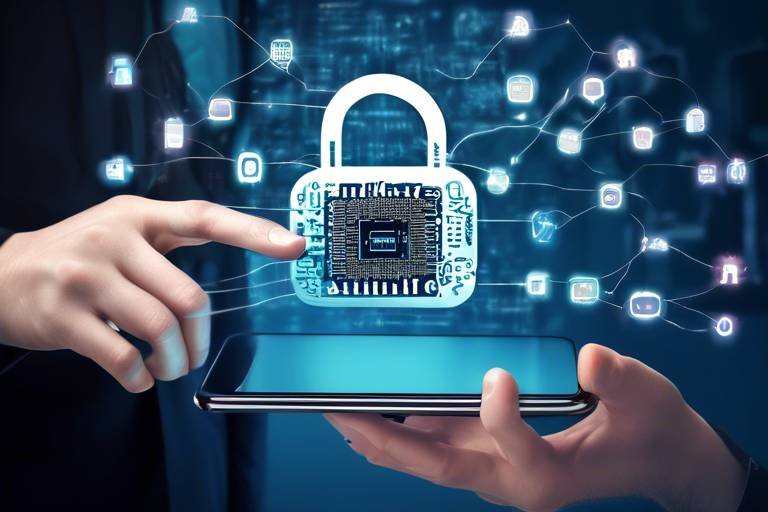The Most Dangerous Types of Malware to Watch Out For
This article explores various types of malware that pose significant threats to individuals and organizations. Understanding these threats is crucial for effective cybersecurity measures and protection against potential data breaches. In a world where our lives are increasingly digital, being aware of the dangers lurking in the shadows of the internet is more important than ever. Just like a lion stalking its prey, malware can strike at any moment, often when we least expect it. So, let’s dive into the murky waters of malware and uncover the most dangerous types to watch out for!
Ransomware is a malicious software that encrypts files, demanding payment for decryption. Imagine waking up one day to find that all your precious photos, documents, and files are locked away, and the only way to get them back is to pay a hefty ransom. Its impact can be devastating, often leading to data loss and financial strain on victims. Ransomware attacks are on the rise, with hackers becoming more sophisticated. They often target businesses, schools, and hospitals, causing operational chaos and financial distress. The best defense? Regular backups and a robust cybersecurity strategy.
Trojans disguise themselves as legitimate software to trick users into installation. Think of them as the wolves in sheep's clothing of the malware world. Once activated, they can create backdoors for attackers, leading to unauthorized access and data theft. Users might download a seemingly harmless app or file, only to find out that it has opened the gates to their personal information. Staying vigilant about what you download and ensuring your software is from reputable sources can help mitigate the risks associated with Trojans.
Spyware secretly monitors user activity and collects sensitive information. Picture someone peeking over your shoulder while you enter your passwords or credit card details online. This type of malware can result in identity theft and unauthorized financial transactions, making it a serious threat to privacy. It often operates quietly in the background, making it difficult to detect. Regularly scanning your devices for spyware and using privacy-focused tools can help keep your information safe.
Adware displays unwanted advertisements on users' devices, often slowing down performance. While less harmful than other malware types, it can lead to privacy concerns and unwanted data collection. Imagine trying to browse the web, only to be bombarded with pop-up ads that disrupt your experience. Not only is it annoying, but adware can also track your browsing habits, raising concerns about how your data is used. Using ad blockers and being cautious about what you install can help reduce adware risks.
Worms are self-replicating malware that spread across networks without user interaction. They can cause extensive damage by consuming bandwidth and exploiting vulnerabilities in systems. Think of worms as the digital equivalent of a virus that spreads rapidly, infecting one machine after another. Organizations need to ensure their systems are patched and updated to prevent worm attacks, as they can quickly escalate into widespread network issues.
Rootkits allow unauthorized users to gain control over a computer while hiding their presence. They are like a secret agent operating within your system, making them difficult to detect. Once installed, rootkits can lead to long-term system compromise, allowing attackers to manipulate your computer without your knowledge. Regular security audits and the use of specialized detection tools can help uncover these stealthy threats.
Keyloggers record keystrokes to capture sensitive information, such as passwords and credit card numbers. Their stealthy operation makes them particularly dangerous for individuals and organizations alike. Imagine someone secretly watching every keystroke you make, gathering your most private information. To combat keyloggers, using virtual keyboards and two-factor authentication can add an extra layer of security.
Fileless malware operates in memory rather than relying on traditional files, making it harder to detect. This type of malware exploits system vulnerabilities to execute malicious actions without leaving a trace. It's like a ghost that haunts your system, invisible yet dangerous. Staying updated with security patches and using advanced threat detection software can help protect against these elusive attacks.
Cryptojacking involves unauthorized use of someone else's computer to mine cryptocurrency. This can significantly degrade system performance and lead to increased energy costs for the victim. Imagine your computer suddenly running slower, and your electricity bill skyrocketing, all because someone else is using your resources to make money. To avoid falling victim to cryptojacking, ensure your systems are secure and monitor for unusual activity.
Q: What is the best way to protect against malware?
A: Regularly update your software, use reputable antivirus programs, and avoid downloading unknown files or applications.
Q: Can I recover files after a ransomware attack?
A: Sometimes, yes. If you have backups, you can restore your files without paying the ransom. However, if you don’t, recovery can be challenging.
Q: How do I know if my device is infected?
A: Look for unusual behavior, such as slow performance, unexpected pop-ups, or programs you didn’t install. Running a security scan can help identify infections.

1. Ransomware
This article explores various types of malware that pose significant threats to individuals and organizations. Understanding these threats is crucial for effective cybersecurity measures and protection against potential data breaches.
Ransomware is one of the most notorious types of malware, and for good reason. Imagine waking up one morning to find that all your important files—photos, documents, and even your work presentations—are locked away, inaccessible without a hefty ransom. This malicious software encrypts files on your system, rendering them useless until the victim pays a ransom for decryption. The impact can be devastating, often leading to data loss and financial strain on victims.
Ransomware attacks can occur in various forms, and the tactics used can be quite sophisticated. For instance, some ransomware variants may use phishing emails to trick users into downloading the malicious software. Others may exploit vulnerabilities in software to gain access to a system. Once the ransomware is inside, it can spread rapidly, encrypting files and demanding payment in cryptocurrencies, making it difficult to trace the perpetrators.
To illustrate the severity of ransomware, consider the following statistics:
| Year | Number of Ransomware Attacks | Average Ransom Amount |
|---|---|---|
| 2019 | 1,500 | $84,000 |
| 2020 | 2,300 | $170,000 |
| 2021 | 4,000 | $300,000 |
As you can see, the number of attacks is rising sharply, along with the average ransom demanded. This trend highlights the importance of taking preventive measures. Here are some steps individuals and organizations can take to protect themselves:
- Regular Backups: Always keep backups of important files in a secure location. This way, even if you fall victim to ransomware, you won't lose your data.
- Update Software: Regularly update your operating system and applications to patch any vulnerabilities that ransomware may exploit.
- Use Antivirus Software: A robust antivirus program can help detect and block ransomware before it can cause damage.
- Educate Employees: For organizations, training employees about phishing attacks and safe browsing habits can significantly reduce the risk of infection.
In conclusion, ransomware is a formidable threat in today's digital landscape. Its ability to cause financial and emotional distress makes it essential for everyone to be aware of its dangers and take proactive steps to safeguard their data. Remember, prevention is always better than cure, especially when dealing with such a malicious adversary.
Q1: What should I do if I become a victim of ransomware?
A1: If you become a victim, do not pay the ransom. Instead, isolate the infected system, report the incident to law enforcement, and seek help from cybersecurity professionals.
Q2: Can ransomware infect my smartphone?
A2: Yes, ransomware can target smartphones, especially if you download apps from untrusted sources. Always download apps from official stores and keep your device updated.
Q3: Is there any way to recover data after a ransomware attack?
A3: If you have backups, you can restore your data. However, if not, recovery can be difficult, and you may need to consult a data recovery specialist.

2. Trojans
Trojans are like the sneaky wolves in sheep's clothing of the digital world. They masquerade as legitimate software, luring unsuspecting users into downloading them. Imagine receiving an email with an attachment that looks like an important document from your boss. You click on it, believing it to be harmless, only to unleash a Trojan that opens the door for cybercriminals to invade your system. This deceptive nature is what makes Trojans particularly dangerous—they exploit trust and curiosity.
Once a Trojan is installed, it can perform a variety of malicious activities without the user's knowledge. It may create backdoors in your system, allowing attackers to gain unauthorized access. This could lead to data theft, where sensitive information such as personal details, financial records, or even corporate secrets can be compromised. The ramifications can be severe, ranging from identity theft to significant financial losses for businesses and individuals alike.
There are several types of Trojans, each with its own unique method of operation:
- Remote Access Trojans (RATs): These allow hackers to take control of your computer remotely, enabling them to manipulate files, access your webcam, and even record your activities.
- Banking Trojans: Specifically designed to steal banking credentials, these Trojans can intercept online transactions and siphon off funds without the victim's knowledge.
- Downloader Trojans: These are designed to download and install additional malicious software onto your system, multiplying the potential damage.
One of the most alarming aspects of Trojans is their ability to remain hidden. They often operate in the background, making them difficult to detect until it's too late. Regular software updates and robust antivirus programs can help mitigate the risk, but users must also remain vigilant. Always verify the source of downloads and be cautious with email attachments, especially from unknown senders.
In essence, Trojans are a reminder of the importance of cybersecurity awareness. Just as you wouldn't open your front door to a stranger, you shouldn't let malicious software into your digital life. Staying informed and proactive is your best defense against these cunning threats.
Q: How can I tell if my computer has a Trojan?
A: Look for unusual behavior, such as slow performance, unexpected pop-ups, or unfamiliar programs running in the background. Running a thorough scan with a trusted antivirus program can help identify and remove Trojans.
Q: Can Trojans be removed easily?
A: While some Trojans can be removed with antivirus software, others may require professional assistance, especially if they have created backdoors or installed additional malware.
Q: What should I do if I suspect a Trojan infection?
A: Disconnect your device from the internet immediately to prevent further data loss, then run a full system scan with an updated antivirus program. If necessary, consult with a cybersecurity professional.

3. Spyware
Spyware is a sneaky type of malware that operates quietly in the background, often without the user's knowledge. Imagine a shadow lurking behind you, constantly watching and recording your every move. That's what spyware does—it secretly monitors your online activities and collects sensitive information, such as passwords, credit card numbers, and personal messages. The implications of such invasions can be staggering, leading to identity theft and unauthorized financial transactions that can wreak havoc on your life.
What's even more alarming is the way spyware can infiltrate your devices. It often disguises itself as legitimate software or is bundled with free applications that seem harmless at first glance. Once installed, it can track your browsing habits, capture keystrokes, and even access your webcam and microphone without your consent. This not only violates your privacy but can also expose you to further attacks by providing cybercriminals with a wealth of personal data.
In a world where our lives are increasingly digital, the threat posed by spyware is more relevant than ever. Here are some common types of spyware you should be aware of:
- Adware: While primarily designed to display ads, some adware can also collect data on your browsing habits.
- Tracking Cookies: These are used by websites to monitor your online behavior, often for targeted advertising.
- System Monitors: These can track everything from your keystrokes to your screenshots, providing attackers with a complete view of your activities.
To protect yourself from spyware, it’s essential to adopt good cybersecurity practices. Regularly update your software, use reputable antivirus programs, and be cautious about the applications you download. Always read user reviews and permissions before installing new software. Remember, if something seems too good to be true, it probably is!
In conclusion, the silent threat of spyware is one that we cannot afford to ignore. By staying informed and vigilant, we can better safeguard our personal information and maintain our privacy in an ever-evolving digital landscape.
Q: What is spyware?
A: Spyware is malicious software designed to secretly monitor user activity and collect sensitive information without their knowledge.
Q: How can I tell if I have spyware on my device?
A: Signs of spyware include slow device performance, unexpected pop-up ads, and unusual behavior from your applications. Running a reputable antivirus scan can also help detect spyware.
Q: How can I protect myself from spyware?
A: To protect against spyware, ensure your software is updated, use strong antivirus protection, be cautious with downloads, and regularly review your privacy settings.

4. Adware
Adware, short for advertisement-supported software, is a type of malware that bombards users with unwanted advertisements. Imagine browsing your favorite website, only to be interrupted by pop-ups and banners that clutter your screen. Not only does this disrupt your online experience, but it can also lead to significant privacy concerns. While adware is generally considered less harmful than other types of malware, it can still cause a range of problems that you should be aware of.
One of the primary issues with adware is its ability to track your online behavior. When you install adware, it often collects data about your browsing habits, preferences, and even your personal information. This data is then used to tailor advertisements to your interests, creating a more invasive and personalized experience. However, this level of tracking raises serious questions about your privacy. Are you comfortable with software monitoring your every click? Many users aren’t even aware that they’ve installed adware, as it often masquerades as legitimate applications or browser extensions.
Moreover, adware can significantly slow down your device's performance. Picture trying to navigate your computer or smartphone, only to find that it lags due to the constant bombardment of ads. This can lead to frustration and decreased productivity, especially for individuals who rely on their devices for work or communication. In some cases, adware may also redirect your web traffic, sending you to unwanted websites or even phishing sites designed to steal your personal information.
To give you a clearer picture of how adware operates, here’s a simple table summarizing its key characteristics:
| Characteristic | Description |
|---|---|
| Tracking | Monitors user behavior and collects data for targeted advertising. |
| Performance Impact | Slows down devices and disrupts user experiences with unwanted ads. |
| Installation | Often bundled with free software, making it easy to install unknowingly. |
| Privacy Risks | Can lead to unauthorized data collection and potential identity theft. |
So, how can you protect yourself from adware? Here are some proactive measures you can take:
- Be Cautious During Installation: Always read the fine print when installing software. Look for any checkboxes that may indicate the installation of additional programs.
- Use Trusted Sources: Download applications only from reputable websites or app stores to minimize the risk of adware.
- Install Anti-Malware Software: A good anti-malware program can help detect and remove adware before it causes problems.
- Regularly Review Installed Programs: Periodically check your device for any unfamiliar software and remove it if necessary.
In conclusion, while adware may not be as notorious as ransomware or keyloggers, it still poses a significant threat to your online experience and privacy. By staying informed and taking proactive steps, you can minimize the risks associated with adware and enjoy a safer browsing experience.
Q: What is adware?
A: Adware is software that automatically displays or downloads advertisements when a user is online, often tracking user behavior for targeted advertising.
Q: Is adware harmful?
A: While adware is generally less harmful than other types of malware, it can still lead to privacy issues and slow down your device.
Q: How can I remove adware?
A: You can remove adware by using anti-malware software, uninstalling suspicious programs, and resetting your browser settings.

5. Worms
Worms are a particularly insidious type of malware that can wreak havoc on both individual computers and entire networks. Unlike other types of malware that often require user interaction to spread, worms are designed to replicate themselves and propagate across systems automatically. This self-replicating nature makes them incredibly dangerous, as they can infect a multitude of devices in a very short period of time. Imagine a small, seemingly harmless bug that quickly multiplies and infests an entire garden; that’s how worms operate in the digital world.
When a worm infiltrates a system, it can consume bandwidth and resources, leading to significant performance degradation. This can be especially problematic for businesses that rely on network efficiency for their operations. In some cases, worms exploit known vulnerabilities in software or operating systems, making it imperative for users to keep their systems updated. The consequences of a worm infection can be severe, ranging from data loss to unauthorized access to sensitive information.
To give you a clearer picture of how worms function, here are some of their key characteristics:
- Self-Replication: Worms can create copies of themselves without needing to attach to a host file, making them unique compared to viruses.
- Network Propagation: They spread through network connections, often exploiting vulnerabilities in network software.
- Payload Delivery: Some worms carry malicious payloads that can install additional malware or create backdoors for attackers.
One of the most notorious examples of a worm is the "ILOVEYOU" worm, which spread through email attachments in the early 2000s. It caused billions of dollars in damage and affected millions of computers worldwide. This incident highlighted the need for robust cybersecurity measures, including firewalls and antivirus software.
In conclusion, the threat posed by worms cannot be overstated. They are a reminder of how interconnected our digital world is and how quickly a small infection can escalate into a full-blown crisis. Staying vigilant, employing security protocols, and educating users about the dangers of unsolicited downloads and email attachments are essential steps in protecting against these malicious programs.
Q: How can I protect my computer from worms?
A: Keeping your operating system and software updated, using a reliable antivirus program, and avoiding suspicious downloads or email attachments can help protect against worm infections.
Q: What should I do if I suspect my computer is infected with a worm?
A: Disconnect from the internet immediately to prevent further spread, run a full antivirus scan, and follow the software's instructions to remove the infection.

6. Rootkits
Rootkits are among the most insidious types of malware you can encounter. They are designed to grant unauthorized users access to a computer while remaining undetected. Think of a rootkit as a stealthy burglar who not only breaks into your house but also meticulously hides their presence, allowing them to roam freely without you ever knowing. This is what makes rootkits particularly dangerous; they can manipulate system processes, files, and even security software without raising alarms.
Once a rootkit has infiltrated a system, it can create a backdoor for attackers, enabling them to execute commands, steal data, or install additional malicious software. The real kicker? Rootkits can operate at various levels of the operating system, from the application level to the kernel level, making them incredibly difficult to detect and remove. Traditional antivirus solutions often struggle against these elusive threats, as they are designed to identify known malware signatures rather than the stealthy tactics employed by rootkits.
To give you a clearer picture of how rootkits function, here’s a breakdown of their characteristics:
| Characteristic | Description |
|---|---|
| Stealth | Rootkits are designed to hide their presence from users and security software. |
| Persistence | They can survive system reboots and even reinstalls of the operating system. |
| Control | Rootkits enable attackers to gain full control over the infected system. |
| Modification | They can alter system files and processes to cover their tracks. |
So, how can you protect yourself from these lurking threats? Here are some steps you can take:
- Keep your operating system and software up to date to patch vulnerabilities.
- Use reputable antivirus and anti-malware programs that include rootkit detection.
- Be cautious about downloading software from untrusted sources.
- Regularly monitor your system for unusual behavior or performance issues.
In conclusion, rootkits represent a significant challenge in the realm of cybersecurity. Their ability to remain hidden while wreaking havoc makes them a preferred tool for cybercriminals. By understanding how they operate and implementing preventive measures, you can better safeguard your systems against these stealthy intruders.
Q: What is a rootkit?
A: A rootkit is a type of malware designed to provide unauthorized access to a computer while concealing its presence.
Q: How can I detect a rootkit on my system?
A: Detection can be challenging, but using advanced security software specifically designed for rootkit detection can help. Regular system scans and monitoring for unusual behavior are also essential.
Q: What should I do if I suspect a rootkit infection?
A: If you suspect a rootkit infection, disconnect your device from the internet and run a thorough scan with reputable security software. In severe cases, you may need to reinstall your operating system.

7. Keyloggers
Keyloggers are one of the sneakiest forms of malware out there, operating quietly in the background while you go about your daily online activities. Imagine someone peering over your shoulder, taking note of every single keystroke you make. That’s essentially what a keylogger does, but instead of a nosy neighbor, it's malicious software designed to capture sensitive information. Whether it’s your passwords, credit card numbers, or personal messages, keyloggers can record everything you type without you even realizing it.
What makes keyloggers particularly dangerous is their stealthy operation. They can be installed through various means, such as phishing emails or bundled with seemingly harmless software. Once embedded in your system, they can transmit your keystrokes to cybercriminals, who can then exploit this information for identity theft or financial fraud. The emotional impact of realizing that your private information has been compromised can be profound, leading to feelings of vulnerability and violation.
Here are some common methods through which keyloggers can infiltrate your system:
- Phishing Attacks: Cybercriminals often send out emails that appear legitimate, tricking users into downloading malware.
- Malicious Software Bundles: Sometimes, keyloggers are packaged with legitimate software, making it easy to unknowingly install them.
- Remote Access Trojans (RATs): These can give hackers direct access to your computer, allowing them to install keyloggers without your consent.
To combat keyloggers, it’s essential to adopt a proactive approach to your cybersecurity. Here are some effective strategies:
- Use Strong Passwords: Create complex passwords that are hard to guess, and change them regularly.
- Two-Factor Authentication: Enable this feature wherever possible to add an extra layer of security.
- Regular Malware Scans: Utilize reputable antivirus software to regularly scan your system for any potential threats.
- Stay Informed: Keep yourself updated on the latest cybersecurity threats and trends to better protect yourself.
In summary, keyloggers may not be the flashiest type of malware, but their ability to quietly steal your most sensitive information makes them incredibly dangerous. By understanding how they operate and taking preventative measures, you can significantly reduce the risk of falling victim to these stealthy attackers.
Q: What are keyloggers?
A: Keyloggers are malware designed to record every keystroke you make on your computer, capturing sensitive information like passwords and credit card numbers.
Q: How can I tell if I have a keylogger on my device?
A: Signs of a keylogger may include unusual computer behavior, such as slow performance, unexpected pop-ups, or unauthorized access to your accounts. Regular malware scans can also help detect them.
Q: Can keyloggers be removed?
A: Yes, keyloggers can be removed using reputable antivirus or anti-malware software. It’s essential to run regular scans and keep your security software updated.
Q: How can I prevent keyloggers from infecting my system?
A: To prevent keyloggers, use strong passwords, enable two-factor authentication, avoid clicking on suspicious links, and keep your software updated.

8. Fileless Malware
This article explores various types of malware that pose significant threats to individuals and organizations. Understanding these threats is crucial for effective cybersecurity measures and protection against potential data breaches.
Ransomware is a malicious software that encrypts files, demanding payment for decryption. Its impact can be devastating, often leading to data loss and financial strain on victims.
Trojans disguise themselves as legitimate software to trick users into installation. Once activated, they can create backdoors for attackers, leading to unauthorized access and data theft.
Spyware secretly monitors user activity and collects sensitive information. This type of malware can result in identity theft and unauthorized financial transactions, making it a serious threat to privacy.
Adware displays unwanted advertisements on users' devices, often slowing down performance. While less harmful than other malware types, it can lead to privacy concerns and unwanted data collection.
Worms are self-replicating malware that spread across networks without user interaction. They can cause extensive damage by consuming bandwidth and exploiting vulnerabilities in systems.
Rootkits allow unauthorized users to gain control over a computer while hiding their presence. They are difficult to detect and can lead to long-term system compromise.
Keyloggers record keystrokes to capture sensitive information, such as passwords and credit card numbers. Their stealthy operation makes them particularly dangerous for individuals and organizations alike.
Fileless malware is a particularly insidious type of malicious software that operates in memory rather than relying on traditional files stored on a hard drive. This characteristic makes it incredibly difficult to detect using conventional antivirus tools, which often scan for identifiable files. Instead, fileless malware exploits existing software and processes in a system, effectively hiding in plain sight. Imagine a thief who wears the clothes of a security guard to sneak into a bank; that's how fileless malware operates, camouflaging itself within legitimate applications.
One of the most alarming aspects of fileless malware is its ability to execute malicious actions without leaving a trace on the hard drive. This means that even if a security scan is performed, the malware may remain undetected, continuing to wreak havoc in the background. It can utilize scripting languages, such as PowerShell or Windows Management Instrumentation (WMI), to carry out its operations, making it a formidable adversary in the realm of cybersecurity.
Here are some key points to understand about fileless malware:
- Stealthy Operation: Because it does not rely on traditional files, it can evade detection by most antivirus programs.
- Exploits Legitimate Software: It often uses trusted applications to execute its code, further complicating detection efforts.
- Memory-Based Attacks: These attacks occur in the system's RAM, which is volatile and does not retain data after a reboot, making forensic analysis challenging.
In summary, fileless malware represents a new frontier in the world of cyber threats. As organizations continue to enhance their cybersecurity measures, attackers are evolving their tactics, and fileless malware is a prime example of this evolution. It’s crucial for individuals and businesses alike to stay informed and adopt comprehensive security measures to mitigate the risks associated with this stealthy threat.
Q1: What is fileless malware?
A1: Fileless malware is a type of malicious software that operates in a computer's memory rather than relying on files stored on the hard drive, making it difficult to detect.
Q2: How does fileless malware spread?
A2: It often exploits vulnerabilities in legitimate software or uses social engineering techniques to trick users into executing malicious scripts.
Q3: What can I do to protect myself from fileless malware?
A3: Regularly update your software, use advanced security solutions that monitor for unusual behavior, and educate yourself about the latest cyber threats.

9. Cryptojacking
Cryptojacking is a sneaky and increasingly common form of cybercrime that involves the unauthorized use of someone else's computer resources to mine cryptocurrency. Imagine waking up one morning to find your computer sluggish, your fan running like a jet engine, and your electricity bill skyrocketing—all because a hacker has hijacked your machine to mine Bitcoin or Ethereum without your consent. This type of malware operates in the shadows, often going unnoticed until the damage is done.
The mechanics behind cryptojacking are quite fascinating yet alarming. It typically begins when a user unknowingly visits a compromised website or downloads a malicious file. Once this occurs, the cryptojacking script activates and begins to utilize the computer's processing power to solve complex mathematical problems that are essential for mining cryptocurrency. The more powerful the computer, the more cryptocurrency is mined, and the more money the hacker makes—all at the expense of the victim's hardware and electricity.
The impact of cryptojacking can be significant, especially for organizations that rely on multiple computers for their operations. When a network of computers is compromised, the cumulative effect can result in a noticeable decline in performance, leading to decreased productivity and increased frustration among users. Additionally, the constant strain on hardware can lead to overheating and potential hardware failure, which can be costly to repair or replace.
Here are some of the key signs that may indicate your device is a victim of cryptojacking:
- Your computer is running slower than usual.
- Increased CPU usage can be seen in the task manager.
- Frequent crashes or unexpected restarts.
- Higher electricity bills without a clear explanation.
To combat cryptojacking, it's essential to adopt a multi-layered approach to cybersecurity. Here are some effective strategies:
- Keep Software Updated: Regularly update your operating system and applications to patch vulnerabilities that hackers might exploit.
- Use Security Software: Invest in reputable antivirus and anti-malware solutions that can detect and block cryptojacking scripts.
- Monitor System Performance: Regularly check your system's performance metrics to catch any unusual activity early.
- Educate Users: If you're part of an organization, educate employees about the risks of cryptojacking and safe browsing practices.
In conclusion, while cryptojacking may seem like a lesser-known threat compared to other forms of malware, its implications can be severe. By understanding how it operates and taking proactive measures, individuals and organizations can protect themselves from this insidious form of cybercrime. Remember, staying informed and vigilant is your best defense against the ever-evolving landscape of cybersecurity threats.
1. What is cryptojacking?
Cryptojacking is the unauthorized use of someone else's computer to mine cryptocurrency, often without their knowledge.
2. How can I tell if my device is being cryptojacked?
Signs include a slow computer, increased CPU usage, unexpected crashes, and higher electricity bills.
3. What can I do to prevent cryptojacking?
Keep your software updated, use security software, monitor system performance, and educate users about safe practices.
Frequently Asked Questions
- What is ransomware and how does it work?
Ransomware is a type of malware that encrypts your files, rendering them inaccessible until you pay a ransom to the attacker. It's like a digital hostage situation where your data is held captive! The impact can be devastating, leading to data loss and financial strain, so it's crucial to have backups and security measures in place.
- How do Trojans differ from other types of malware?
Trojans masquerade as legitimate software to trick users into downloading them. Once installed, they can create backdoors for attackers, allowing unauthorized access to your system. Think of them as wolves in sheep's clothing—appearing harmless but hiding malicious intent!
- What are the risks associated with spyware?
Spyware secretly monitors your activities and collects sensitive information like passwords and credit card numbers. This can lead to identity theft and unauthorized financial transactions. It's like having a hidden camera in your home—completely violating your privacy!
- Is adware harmful?
While adware primarily displays unwanted ads and can slow down your device, it can also lead to privacy concerns. It collects data about your browsing habits, which can be used for targeted advertising. So, while it might not be as dangerous as ransomware, it's still a nuisance you want to avoid!
- What are worms and how do they spread?
Worms are a type of self-replicating malware that spreads across networks without any user interaction. They can consume bandwidth and exploit system vulnerabilities, causing extensive damage. Imagine a digital parasite that multiplies and spreads, wreaking havoc on everything in its path!
- What is a rootkit and why is it dangerous?
A rootkit allows unauthorized users to gain control of a computer while hiding its presence. It’s tough to detect and can lead to long-term system compromise. Think of it as a secret passageway that lets intruders sneak into your home without you ever knowing!
- How do keyloggers capture sensitive information?
Keyloggers record your keystrokes, capturing everything you type, including passwords and credit card numbers. Their stealthy operation makes them particularly dangerous, as they can operate without your knowledge. It's like having a sneaky eavesdropper listening in on your most private conversations!
- What is fileless malware?
Fileless malware operates in memory instead of relying on traditional files, making it harder to detect. It exploits system vulnerabilities to execute malicious actions, like a ghost that can move through walls—elusive and difficult to catch!
- What is cryptojacking and how does it affect my computer?
Cryptojacking involves unauthorized use of your computer to mine cryptocurrency. This can significantly degrade system performance and lead to increased energy costs, like having an unwelcome guest who hogs all your resources without contributing anything!



















